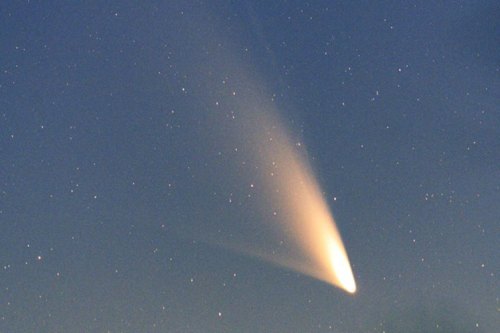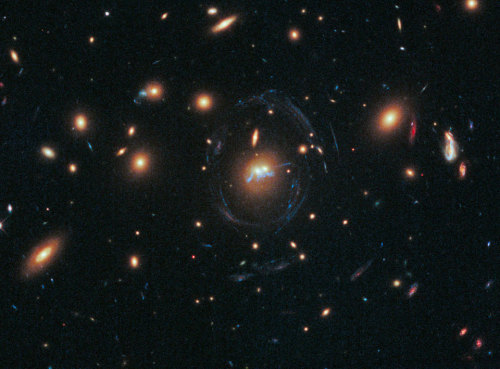Comet Panstarrs – Seen From Queenstown, New Zealand (March 2, 2013)

Comet Panstarrs – Seen from Queenstown, New Zealand (March 2, 2013)
Credit – Minoru Yoneto
More Posts from Intergalacticnerd and Others
LIGO Gravitational Wave Chirp - Chirp pattern of gravitational waves detected by LIGO on September 14, 2015. Credit: LIGO http://www.ligo.org/








We used to look up at the sky and wonder at our place in the stars. Now we just look down, and worry about our place in the dirt.

M7, Open Star Cluster

A Blue Bridge of Stars between Cluster Galaxies designated SDSS J1531+3414

SN 1006 Supernova Remnant by NASA, ESA and Zolt Levay

Orion and the Horse-head in Infrared
This wide image of the Orion Molecular Cloud Complex features the Flame nebula (NGC 2024) and the Horsehead nebula (NGC 2023). In this infrared image, the Horsehead can be seen on the bottom right as a small wisp of gas protruding from the complex. The colors in this image do not represent visible light because it was imaged with the Spritzer Space Telescope - which can only see infrared light. As a result, scientist must map temperatures to colors. Cooler objects, such as the dust of the nebulae, appear green and red and hotter objects appear more blue. Astronomers are essentially “shifting” the infrared light into the visible spectrum.
Credit: NASA/JPL/Cal Tech

The Trapezium is that a space ghost?
js
What’s Up for May 2016?

What’s Up for May? Two huge solar system highlights: Mercury transits the sun and Mars is closer to Earth than it has been in 11 years.

On May 9, wake up early on the west coast or step out for coffee on the east coast to see our smallest planet cross the face of the sun. The transit will also be visible from most of South America, western Africa and western Europe.

A transit occurs when one astronomical body appears to move across the face of another as seen from Earth or from a spacecraft. But be safe! You’ll need to view the sun and Mercury through a solar filter when looking through a telescope or when projecting the image of the solar disk onto a safe surface. Look a little south of the sun’s Equator. It will take about 7 ½ hours for the tiny planet’s disk to cross the sun completely. Since Mercury is so tiny it will appear as a very small round speck, whether it’s seen through a telescope or projected through a solar filter. The next Mercury transit will be Nov. 11, 2019.

Two other May highlights involve Mars. On May 22 Mars opposition occurs. That’s when Mars, Earth and the sun all line up, with Earth directly in the middle.

Eight days later on May 30, Mars and Earth are nearest to each other in their orbits around the sun. Mars is over half a million miles closer to Earth at closest approach than at opposition. But you won’t see much change in the diameter and brightness between these two dates. As Mars comes closer to Earth in its orbit, it appears larger and larger and brighter and brighter.

During this time Mars rises after the sun sets. The best time to see Mars at its brightest is when it is highest in the sky, around midnight in May and a little earlier in June.

Through a telescope you can make out some of the dark features on the planet, some of the lighter features and sometimes polar ice and dust storm-obscured areas showing very little detail.

After close approach, Earth sweeps past Mars quickly. So the planet appears large and bright for only a couple weeks.

But don’t worry if you miss 2016’s close approach. 2018’s will be even better, as Mars’ close approach will be, well, even closer.
You can find out about our #JourneytoMars missions at mars.nasa.gov, and you can learn about all of our missions at http://www.nasa.gov.
Make sure to follow us on Tumblr for your regular dose of space: http://nasa.tumblr.com









We’ve always defined ourselves by the ability to overcome the impossible. And we count these moments. These moments when we dare to aim higher, to break barriers, to reach for the stars, to make the unknown known. We count these moments as our proudest achievements. But we lost all that. Or perhaps we’ve just forgotten that we are still pioneers. And we’ve barely begun. And that our greatest accomplishments cannot be behind us, because our destiny lies above us.
Interstellar (2014) dir. Christopher Nolan


February 7, 1984 – Astronauts Bruce McCandless II and Robert L. Stewart make the first untethered spacewalk using the Manned Maneuvering Unit (MMU) during mission STS-41B of the Space Shuttle Challenger.
(NASA)
-
 partigrade reblogged this · 1 week ago
partigrade reblogged this · 1 week ago -
 jonaki039 liked this · 1 week ago
jonaki039 liked this · 1 week ago -
 coolstorybrahhh liked this · 1 week ago
coolstorybrahhh liked this · 1 week ago -
 che-rohayhu reblogged this · 1 week ago
che-rohayhu reblogged this · 1 week ago -
 lonelyworld reblogged this · 1 week ago
lonelyworld reblogged this · 1 week ago -
 stiles-r reblogged this · 1 week ago
stiles-r reblogged this · 1 week ago -
 muziginhuzuru reblogged this · 1 week ago
muziginhuzuru reblogged this · 1 week ago -
 blackpapatyadam liked this · 1 week ago
blackpapatyadam liked this · 1 week ago -
 westdayever reblogged this · 1 week ago
westdayever reblogged this · 1 week ago -
 maviitiilkii reblogged this · 1 week ago
maviitiilkii reblogged this · 1 week ago -
 maviitiilkii liked this · 1 week ago
maviitiilkii liked this · 1 week ago -
 imdoesntsharefood reblogged this · 1 week ago
imdoesntsharefood reblogged this · 1 week ago -
 amanlanaxx liked this · 1 week ago
amanlanaxx liked this · 1 week ago -
 undertheinfluencex1 liked this · 1 week ago
undertheinfluencex1 liked this · 1 week ago -
 stiles-r reblogged this · 1 week ago
stiles-r reblogged this · 1 week ago -
 californialordu reblogged this · 1 week ago
californialordu reblogged this · 1 week ago -
 infrarred reblogged this · 1 week ago
infrarred reblogged this · 1 week ago -
 gallerypeice liked this · 2 weeks ago
gallerypeice liked this · 2 weeks ago -
 run2there reblogged this · 2 weeks ago
run2there reblogged this · 2 weeks ago -
 kurbagalandin reblogged this · 2 weeks ago
kurbagalandin reblogged this · 2 weeks ago -
 sunazuri reblogged this · 2 weeks ago
sunazuri reblogged this · 2 weeks ago -
 regisneotrazim liked this · 2 weeks ago
regisneotrazim liked this · 2 weeks ago -
 thoughtfulharmonytastemaker liked this · 2 weeks ago
thoughtfulharmonytastemaker liked this · 2 weeks ago -
 oppossums reblogged this · 2 weeks ago
oppossums reblogged this · 2 weeks ago -
 desertcoyote liked this · 2 weeks ago
desertcoyote liked this · 2 weeks ago -
 vethril reblogged this · 2 weeks ago
vethril reblogged this · 2 weeks ago -
 lazy-little-leaf liked this · 2 weeks ago
lazy-little-leaf liked this · 2 weeks ago -
 fleurmeadows reblogged this · 2 weeks ago
fleurmeadows reblogged this · 2 weeks ago -
 undertheinfluencex1 reblogged this · 2 weeks ago
undertheinfluencex1 reblogged this · 2 weeks ago -
 itwillgetbetteriswearitwill reblogged this · 2 weeks ago
itwillgetbetteriswearitwill reblogged this · 2 weeks ago -
 itwillgetbetteriswearitwill liked this · 2 weeks ago
itwillgetbetteriswearitwill liked this · 2 weeks ago -
 houndsister reblogged this · 2 weeks ago
houndsister reblogged this · 2 weeks ago -
 ryunorintaro liked this · 2 weeks ago
ryunorintaro liked this · 2 weeks ago -
 manqoz reblogged this · 2 weeks ago
manqoz reblogged this · 2 weeks ago -
 llllovely-bones reblogged this · 2 weeks ago
llllovely-bones reblogged this · 2 weeks ago -
 fiancetwt reblogged this · 2 weeks ago
fiancetwt reblogged this · 2 weeks ago -
 fiancetwt liked this · 2 weeks ago
fiancetwt liked this · 2 weeks ago -
 alexrainbow liked this · 2 weeks ago
alexrainbow liked this · 2 weeks ago -
 taikeai liked this · 2 weeks ago
taikeai liked this · 2 weeks ago -
 pistachiostrawberry reblogged this · 2 weeks ago
pistachiostrawberry reblogged this · 2 weeks ago -
 akakaze liked this · 2 weeks ago
akakaze liked this · 2 weeks ago -
 anewstage reblogged this · 2 weeks ago
anewstage reblogged this · 2 weeks ago -
 elderfleurs reblogged this · 2 weeks ago
elderfleurs reblogged this · 2 weeks ago -
 kudzoi reblogged this · 2 weeks ago
kudzoi reblogged this · 2 weeks ago -
 hoppingoutcasketfresh reblogged this · 2 weeks ago
hoppingoutcasketfresh reblogged this · 2 weeks ago -
 hoppingoutcasketfresh liked this · 2 weeks ago
hoppingoutcasketfresh liked this · 2 weeks ago -
 sukaato liked this · 2 weeks ago
sukaato liked this · 2 weeks ago -
 rambozil reblogged this · 2 weeks ago
rambozil reblogged this · 2 weeks ago -
 icedmatchaa reblogged this · 2 weeks ago
icedmatchaa reblogged this · 2 weeks ago -
 icedmatchaa liked this · 2 weeks ago
icedmatchaa liked this · 2 weeks ago
"Astronomy compels the soul to look upwards and leads us from this world to another." - Plato
147 posts